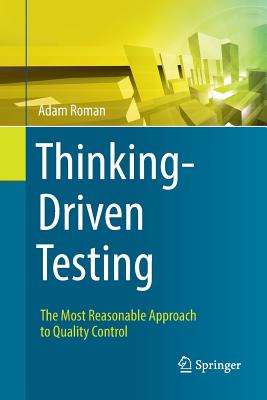Thinking-Driven Testing: The Most Reasonable Approach to Quality Control
暫譯: 思維驅動測試:最合理的品質控制方法
Adam Roman
- 出版商: Springer
- 出版日期: 2018-03-27
- 售價: $3,370
- 貴賓價: 9.5 折 $3,202
- 語言: 英文
- 頁數: 305
- 裝訂: Hardcover
- ISBN: 3319731947
- ISBN-13: 9783319731940
-
相關分類:
Unit Test 單元測試
海外代購書籍(需單獨結帳)
相關主題
商品描述
This book presents a new paradigm of software testing by emphasizing the role of critical thinking, system thinking and rationality as the most important skills for the tester. It thus approaches software testing from a different perspective than in past literature, as the vast majority of books describe testing in the context of specific tools, automation, documentation, particular test design techniques or test management. In addition, the book proposes a novel meta-approach for designing effective test strategies, which is based on recent advances in psychology, economics, system sciences and logic.
Chapter 1 starts by introducing the fundamental ideas underlying software testing. Chapter 2 then describes meta-strategies in software testing, i.e. general approaches that can be adapted to many different situations that a software tester encounters. Next, Chapter 3 presents the concept of Thinking-Driven Testing (TDT). This approach utilizes the concepts discussed in the two previous chapters and introduces the main ideas that underlie a reasonable and optimal approach to software testing. Chapter 4 builds on this basis and proposes a specific approach to testing, called TQED, that makes it possible to increase creativity in the context of delivering effective, optimal test ideas. Chapter 5 provides an overview of different types of testing techniques in order to understand the fundamental concepts of test design, while Chapter 6 details various pitfalls a tester may encounter and that can originate from a wide range of testing process areas. Lastly, Chapter 7 puts all this into practice, as it contains several exercises that will help testers develop a number of crucial skills: logical thinking and reasoning, thinking out of the box, creativity, counting and estimating, and analytical thinking.
By promoting critical, rational and creative thinking, this book invites readers to re-examine common assumptions regarding software testing and shows them how to become professional testers who bring added value to their company.
商品描述(中文翻譯)
這本書提出了一種新的軟體測試範式,強調批判性思維、系統思維和理性作為測試者最重要的技能。因此,它從不同於過去文獻的角度來看待軟體測試,因為絕大多數書籍都是在特定工具、自動化、文檔、特定測試設計技術或測試管理的背景下描述測試。此外,本書提出了一種新穎的元方法,用於設計有效的測試策略,這基於心理學、經濟學、系統科學和邏輯的最新進展。
第一章首先介紹了軟體測試的基本理念。第二章接著描述了軟體測試中的元策略,即可以適應軟體測試者所遇到的許多不同情況的一般方法。接下來,第三章介紹了思維驅動測試(Thinking-Driven Testing, TDT)的概念。這種方法利用前兩章中討論的概念,並介紹了合理和最佳的軟體測試方法的主要思想。第四章在此基礎上提出了一種特定的測試方法,稱為TQED,這使得在提供有效、最佳的測試想法的背景下增加創造力成為可能。第五章概述了不同類型的測試技術,以便理解測試設計的基本概念,而第六章詳細說明了測試者可能遇到的各種陷阱,這些陷阱可能源自廣泛的測試過程領域。最後,第七章將所有這些付諸實踐,包含幾個練習,幫助測試者發展多項關鍵技能:邏輯思維和推理、跳出框架思考、創造力、計算和估算,以及分析性思維。
通過促進批判性、理性和創造性思維,本書邀請讀者重新檢視有關軟體測試的常見假設,並展示如何成為為公司帶來附加價值的專業測試者。











